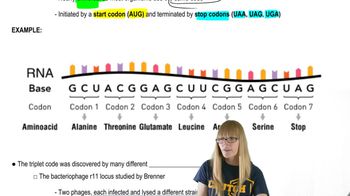Recombinant human insulin (made by inserting human DNA encoding insulin into E. coli) is one of the most widely used recombinant pharmaceutical products in the world. What segments of the human insulin gene are used to create recombinant bacteria that produce human insulin?
Table of contents
- 1. Introduction to Genetics51m
- 2. Mendel's Laws of Inheritance3h 37m
- 3. Extensions to Mendelian Inheritance2h 41m
- 4. Genetic Mapping and Linkage2h 28m
- 5. Genetics of Bacteria and Viruses1h 21m
- 6. Chromosomal Variation1h 48m
- 7. DNA and Chromosome Structure56m
- 8. DNA Replication1h 10m
- 9. Mitosis and Meiosis1h 34m
- 10. Transcription1h 0m
- 11. Translation58m
- 12. Gene Regulation in Prokaryotes1h 19m
- 13. Gene Regulation in Eukaryotes44m
- 14. Genetic Control of Development44m
- 15. Genomes and Genomics1h 50m
- 16. Transposable Elements47m
- 17. Mutation, Repair, and Recombination1h 6m
- 18. Molecular Genetic Tools19m
- 19. Cancer Genetics29m
- 20. Quantitative Genetics1h 26m
- 21. Population Genetics50m
- 22. Evolutionary Genetics29m
11. Translation
The Genetic Code
Problem 29b
Textbook Question
Shown here are the amino acid sequences of the wild-type and three mutant forms of a short protein.
___________________________________________________
Wild-type: Met-Trp-Tyr-Arg-Gly-Ser-Pro-Thr
Mutant 1: Met-Trp
Mutant 2: Met-Trp-His-Arg-Gly-Ser-Pro-Thr
Mutant 3: Met-Cys-Ile-Val-Val-Val-Gln-Hi
___________________________________________________
Use this information to answer the following questions:
For each mutant protein, determine the specific ribonucleotide change that led to its synthesis.
 Verified step by step guidance
Verified step by step guidance1
Step 1: Understand that each amino acid in a protein is encoded by a set of three nucleotides called a codon in the mRNA, which is transcribed from the DNA sequence. To find the ribonucleotide change, you need to compare the mutant amino acid sequence to the wild-type sequence and identify where the differences occur.
Step 2: For Mutant 1, note that the sequence is truncated after the second amino acid (Met-Trp). This suggests a premature stop codon appeared after the second codon. Identify the codon for the third amino acid in the wild-type (Tyr) and determine which single nucleotide change could convert it into a stop codon (UAA, UAG, or UGA).
Step 3: For Mutant 2, observe that the third amino acid is His instead of Tyr, while the rest of the sequence matches the wild-type. Find the codons for Tyr and His, then determine the single nucleotide substitution that changes the Tyr codon to a His codon.
Step 4: For Mutant 3, the entire sequence is different starting from the second amino acid. Compare each amino acid in Mutant 3 to the wild-type sequence and identify the codons for the new amino acids. This suggests multiple nucleotide changes or a frameshift mutation. Consider whether a single nucleotide change can explain the differences or if a more complex mutation occurred.
Step 5: Summarize the specific ribonucleotide changes by writing the original codon and the mutated codon for each affected amino acid, showing the exact nucleotide substitution(s) responsible for the mutant protein sequences.
 Verified video answer for a similar problem:
Verified video answer for a similar problem:This video solution was recommended by our tutors as helpful for the problem above
Video duration:
2mPlay a video:
Was this helpful?
Key Concepts
Here are the essential concepts you must grasp in order to answer the question correctly.
Genetic Code and Codon-Amino Acid Relationship
The genetic code consists of nucleotide triplets called codons, each specifying a particular amino acid. Understanding how codons translate into amino acids is essential to link changes in nucleotide sequences (mutations) to alterations in protein sequences. This relationship allows prediction of nucleotide changes from observed amino acid substitutions.
Recommended video:
Guided course

The Genetic Code
Types of Mutations and Their Effects on Protein Sequence
Mutations such as nonsense, missense, and frameshift mutations alter the nucleotide sequence and consequently the amino acid sequence. For example, a nonsense mutation introduces a premature stop codon, truncating the protein, while missense mutations substitute one amino acid for another. Recognizing these mutation types helps explain the differences between wild-type and mutant proteins.
Recommended video:
Guided course

Point Mutations
Translation Termination and Its Impact on Protein Length
Translation stops when a stop codon (UAA, UAG, UGA) is encountered, resulting in protein termination. Mutations that create premature stop codons lead to shorter proteins, as seen in truncated mutants. Understanding how stop codons function is crucial to deducing which nucleotide changes cause early termination in mutant proteins.
Recommended video:
Guided course

Translation Termination
Related Videos
Related Practice
Textbook Question
557
views


